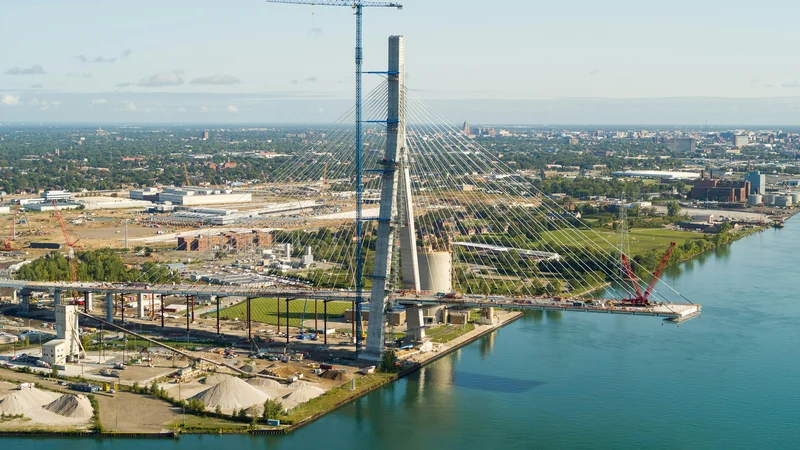Headlines will tell you the Gordie Howe International Bridge is delayed. They’ll use words like “pushed back” and “setback.” And technically, they’re right. The grand opening, once slated for this fall, is now on the calendar for early 2026. But to see this merely as a missed deadline is to miss the entire point. It’s like looking at a nearly finished cathedral and complaining that the stained-glass windows are taking a while to install.
What we’re witnessing isn’t a failure of scheduling. It’s a testament to ambition.
This bridge was never just about getting trucks from I-75 to Highway 401 a little faster. It’s a $5.7 billion, 1.6-mile-long declaration of faith in the future of North American collaboration, a physical manifestation of a bond between two nations. When you’re building a legacy, you don’t rush the final, critical steps. You measure, you test, you perfect. The delay isn’t a problem; it’s proof that the teams involved understand the gravity of what they’re creating. When I first saw the images of those 5,000 brilliant white LED lights tracing the stay cables against the night sky, I honestly just sat back in my chair, speechless. This isn't just infrastructure; it's a piece of kinetic sculpture connecting two countries.
More Than Concrete and Steel
Let's take a step back and appreciate the sheer scale of this thing. The two main towers rise 720 feet into the air. The bridge deck will sit 150 feet above the Detroit River, making it one of the longest and tallest crossings in North America. This isn’t a weekend DIY project. It’s a modern marvel, a 21st-century answer to the monumental undertakings of the past, like the Hoover Dam or the Golden Gate Bridge. Those projects weren't just about power or transit; they were bold, audacious statements about what we, as a society, were capable of achieving. They were built to inspire awe, and they were built to last.
The Gordie Howe bridge is in that same class. The project team is now deep in the finishing stages—the paving, the landscaping, the construction of pedestrian bridges, and the exhaustive safety testing of every single system—and this is the kind of meticulous, painstaking work that separates a good project from a truly great one. It's a symphony of logistics that has to be perfect, not just fast.

Think about what it’s replacing. For decades, the flow of goods and people between Detroit and Windsor has been funneled through the privately-owned Ambassador Bridge, a structure that forces traffic directly into city centers, causing congestion and bottlenecks. The Gordie Howe is designed as an elegant bypass, a high-tech artery built for flow. It incorporates numerous inspection lanes and advanced truck processing systems, with toll transponders designed to handle 400 vehicles an hour at each station. This is about designing for the next 100 years, not just the next 10. So, are we really going to begrudge them a few extra months to ensure every weld, every line of code, and every safety protocol is flawless?
The Anatomy of a 'Productive' Delay
Let’s look at the official reason for the new 2026 timeline. In a statement regarding the Opening of Gordie Howe Bridge delayed until 2026, Heather Grondin of the Windsor-Detroit Bridge Authority (WDBA) cited the need for "ongoing quality reviews, testing and commissioning." She also mentioned giving border agencies enough time to be ready. This isn't an excuse; it's a sign of profound responsibility.
The bridge is being delivered through a public-private partnership—which, in simpler terms, means you have the accountability of a government-owned Canadian Crown corporation like the WDBA ensuring the project serves the public good, while leveraging the focused execution of private construction partners. It’s a model designed to deliver massive, complex projects. But even the best models must bow to the realities of building something this unprecedented. You don’t just flip a switch on a port of entry this large and hope for the best. You drill, you simulate, and you prepare relentlessly.
This is the kind of breakthrough that reminds me why I got into this field in the first place. We’ve become so accustomed to the digital world’s mantra of "move fast and break things" that we’ve forgotten that in the physical world, the things you build can’t be broken. Especially not when they’re designed to carry 6,000 commuters a day and a significant portion of the trade between two of the world's largest economic partners. The meticulous safety checks and system integrations aren’t red tape; they are the invisible architecture of trust.
What does it say about our priorities when we choose to get something this monumental right instead of just getting it done by a date on a calendar? To me, it says we're finally learning the right lessons. It signals a return to craftsmanship on a civilizational scale.
Building for a Century, Not a Deadline
So, let's reframe the narrative. The Gordie Howe International Bridge is not late. It is being painstakingly and deliberately perfected. This isn't a story about a delay; it's a story about a deep, abiding commitment to excellence. In an era of disposable products and fleeting digital trends, the teams in Detroit and Windsor are building something permanent, something tangible, something that will stand long after we are gone. They are building for a century, not for a quarterly report. And that is something worth waiting for.
